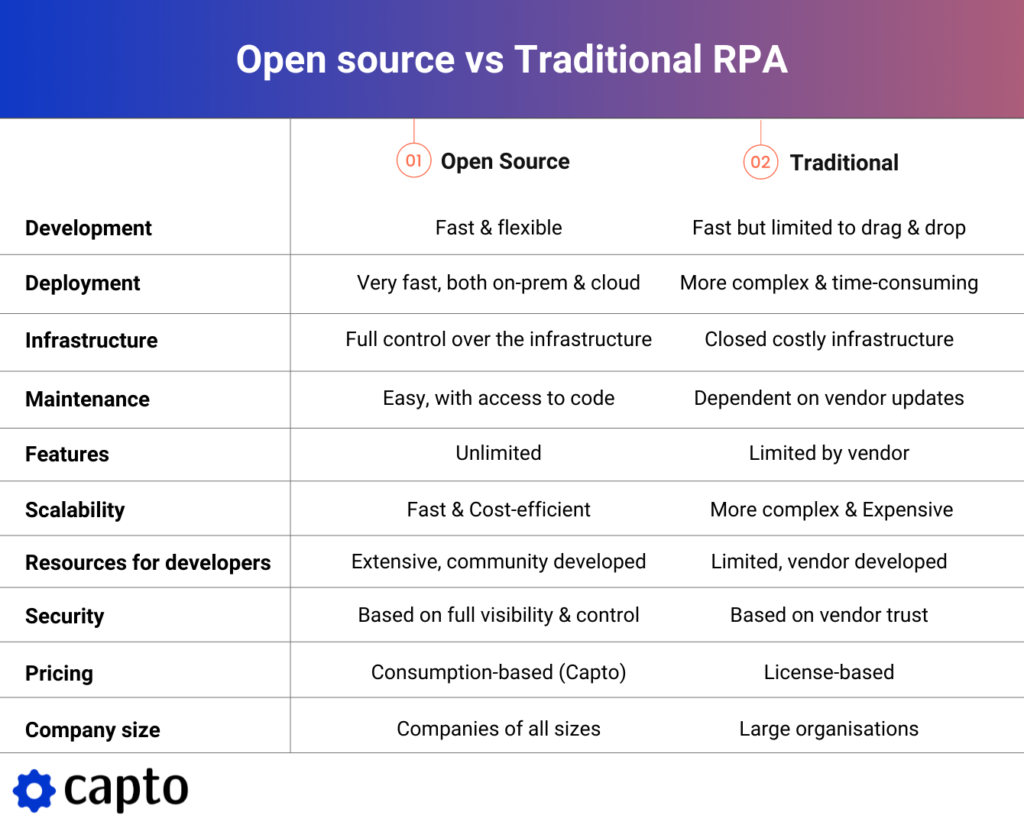What is open source RPA?
Before we dive into open source RPA, let’s briefly discuss Robotic process automation (RPA) more generally. RPA is often the first step toward automation for many businesses. Often businesses look no further to automate manual, multistep tasks that typically take a human a long time to complete. However, RPA as a technology is evolving quickly. This means that it can now handle with perfection not only swivel-chair processes but also end-to-end process automation.
RPA has the power to significantly increase the volume of business you attend to. It’s also powerful in fueling innovation and creativity in teams. And sure, it’s also got the potential to reduce costs by 30% to 50%.
With the increasing need for automation, the discussion about what type of RPA to implement becomes more and more topical. So here’s a summary of two main categories of RPA on the market today. Open source and closed, or traditional, RPA.
Open source RPA is robotic process automation where software robots are built using an open-source coding program or language that is publicly accessible and often (but not always) free to use. This effectively means that when a developer creates your robot, he/ she writes the code using one of the top open source RPA frameworks or simply python.
At Capto, for example, we use mostly python to build our customized robots. This means that we don’t engage with a commercial vendor. This helps us keep pricing low, quality and flexibility high, and security fully in control.
What is traditional RPA?
Traditional RPA, on the other hand, is what we refer to when we hear expressions such as licensed RPA and commercial RPA. This type of RPA is indeed based on developer licenses and is proprietary. This means that the developer building your bot doesn’t have access to the underlying source code. Developers are effectively left with a drag-and-drop-like interface, or low-code functionality, to build all required bots.
Differences between open source RPA and traditional RPA
The differences between the two “schools” of RPA are many and all pretty fundamental. To understand them better let’s talk through them one by one:
Development
One of the key differences between open source and traditional RPA is the way the bots are developed. With open source RPA, bots are developed using python or another open source language or framework. This means that the developer has direct access to the source code and can improve it, update it and maintain it directly at all times.
With traditional RPA the developer has no direct access to the underlying code. Instead, he/ she uses a drag and drop interface or low code to build the required bots or workflows. This can make it quite hard for developers to build the exact solution desired by the end-user. This is due to the inherent proprietary systems and the reduced flexibility since developers can only use the set of features made available by the vendor.
Deployment
Open source RPA ensures a very fast, and hands-off deployment. Deployment can be done on your desktop or the cloud depending on the specific requirements. In both cases, however, deployment is done pretty smoothly and with no major bottlenecks.
Traditional RPA historically used to offer only on-premise deployment. This was expensive, taking a long time, and was often associated with extensive maintenance efforts to keep up the on-premise servers. Nowadays, however, most traditional RPA providers offer a cloud deployment as well which is expected to reduce the deployment time and make it far easier to complete successfully.
Infrastructure
With open-source RPA you have full control over the infrastructure. What that means is that you decide where to host your bot, on a desktop, on-premise server, or the cloud. If the cloud option is preferred, you then have full control over which server to use.
Traditional RPA, on the other hand, is inherently associated with a closed costly infrastructure. Here you also have control over where your bots are hosted. However, it’s up to the vendor to choose the server provider. This means you have limited control over the overall cost since this is pushed by the vendor.
Maintenance
With open source RPA maintenance is required following third-party updates. Say your bot connects to Facebook and Facebook makes a big update to its platform. This will potentially require the developer to make adjustments to the bot to make sure it works smoothly with the new version of Facebook.
With traditional RPA, however, maintenance is required not only because of third-party updates but also updates pushed by the vendor. The latter is completely outside of developers’ control. What’s incredibly important to mention here is that the rate of broken bots with traditional RPA has been notoriously high.
The reason for this is mainly due to auto-updates of the vendor systems over which developers have no control. This, coupled with insufficient documentation on the updates, makes the successful maintenance of bots tricky and costly.
Thankfully, this issue is not in scope with open source RPA. This is the case because with most open-source software and languages, python especially, developers have full control over the versions of the frameworks and libraries used in building the bots. Importantly, the version used in creating your robot will not change automatically with future updates, unless your developer decides so.
Features
With open source RPA the features that your robot can have are virtually limitless. Developers have access to the code. As such he/she can be as creative as he/she wishes to achieve ultimate customization.
With closed RPA, the features that developers can use are vendor specified. This means that developers can only use the features included in the vendor’s set of features. This can become limiting both in terms of the functionality of the robots and the creativity that developers can unleash.
Scalability
Going hand in hand with the flexibility and control over infrastructure and features, open source RPA allows for fast scalability. Not only that but it’s also the most cost-efficient option on the market today to scale RPA. More on that in the pricing section below.
Traditional RPA has made a name for itself when it comes to the scalability of RPA. This is mostly driven by traditional vendors being the only trusted option on the market until recent years when open source RPA started to shake things up. Scalability with traditional RPA is still perceived as best achieved with traditional vendors. However, that only applies to businesses that can justify the large investment required.
Resources for developers
When we talk about open source RPA we talk about an active global community of thousands of developers and contributors. The amount of documentation that is available is also impressively extensive and free to access.
In comparison, the resources available for developers using traditional RPA are made available from the relevant vendors. As such, they tend to be limited when compared with open source RPA. This is the reason why often when traditional bots break, it takes quite a bit of time to find and resolve the problem.
Security
With access comes control. With control comes security. Open source RPA ensures robust security since at any point the code can be audited. Also, with access to the underlying source code, developers can see, locate, and fix vulnerabilities in the code as well as any bugs.
Traditional RPA is inherently closed. This means that the code making up your robot is not visible to you or your developer at any point. It is only accessible by the RPA vendor. As such, security is based entirely on trust.
Pricing
Open source is a low-risk low-cost way of getting started with RPA. If you have the development resources on your team, you can build some test robots virtually for free. At Capto we use open source technology and adopt a consumption-based pricing model where the price is determined by the amount of work your bots get through. This means that you are paying for the direct value you receive from your bot 🙂
In comparison, traditional RPA adopts license-based pricing. This means that an annual license is required for each robot you need to be deployed. As such, the upfront investment is pretty high and makes scalability a very pricey undertaking.
Important point to make here is that with open source RPA you can now bring as many robots as you need in solving one problem because you don’t pay per robot but per consumption. This compares with having 1 single licensed bot doing everything on its own. Why having just 1 licensed bot doing all the work? Because with traditional RPA you you pay per robot not job done, and the amount is pretty significant so it’s hard to justify the extra cost.
Company size
Traditionally licensed RPA was created and continues to be used by large organizations that can justify the high cost. We’re talking about large companies with complex processes the automation of which would delivers a high enough ROI to justify the investment into a robot.
With open source RPA the discussion about company size and who can afford RPA becomes irrelevant. That is the case because companies of all sizes can start using RPA virtually for free if they have the development skill in the team. If external help is required, the upfront cost tends to be insignificant or in some cases none which means that every company can afford it and start benefiting.
Conclusion

In summary, these are the main differences between open source and closed traditional RPA. Which type of RPA you go with is inherently a blend between appetite for flexibility, security, cost, and speed. As such, there are no one-size-fits-all solutions as the wider business circumstances and the specific project requirements could weigh the scale in either direction. What we encourage businesses of all sizes to do is consider all options and make decisions based on complete information. Also, if you or anyone of your teams need further information, make sure to consult!
Our team at Capto is here to help with any automation-related questions so feel free to leave us a comment or if you want to speak to us directly, you can book a call with one of our experts. And yes, it’s free and without any strings attached.



